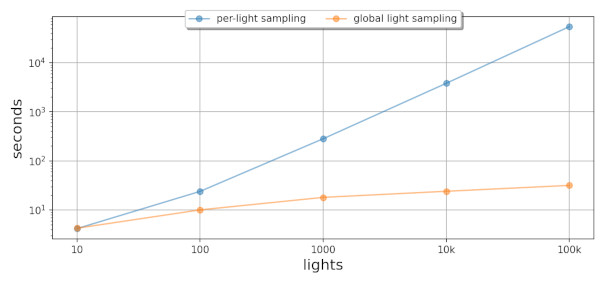Autodesk ships Arnold 7.2.1
Autodesk has released Arnold 7.2.1, the latest version of the production renderer, adding an eye-catching new distance shader and support for global light sampling, and extending USD support.
The plugins for 3ds Max, Cinema 4D, Houdini and Maya have all been updated to support the new features.
New distance shader creates amazing motion-graphics-style effects
The most eye-catching feature in Arnold 7.2.1 is the distance shader, which uses sample rays to estimate the distance from the shading point to the nearest surface, then maps that distance to a colour gradient.
That makes it possible to create beautiful motion-graphics-style effects, in which concentric bands of colour are generated on surfaces according to their distance from surrounding objects.
You can see the range of possibilities in the video above, created by in-house artist Lee Griggs, who has a set of video tutorials on how to use the distance shader on his blog.

Global light sampling cuts render times in scenes with many lights
Other new features include global light sampling, which reduces render times in scenes with multiple lights.
Render times are equal in scenes with up to 10 lights, but the benefit increases as more lights are introduced, with global light sampling becoming over 100x faster than per-light sampling in scenes with 10,000 lights.
Expanded USD support and performance improvements
The update also extends USD support, adding support for more MaterialX shaders: Arnold now supports the MaterialX Standard Library shaders for creating and manipulating BSDFs, VDF and EDFs.
In addition, geometric primitives are now converted to Hydra meshes instead of Arnold primitives.
Performance improvements include faster loading of OpenVDB volumes in Windows, particularly on multi-core GPUs: according to the release notes, loading is up to “4.5x faster” on a 112-core machine.
Supported by all of the integration plugins
Arnold’s integration plugins have also been updated to support the new features:
3ds Max: MAXtoA 5.6.1.0
Cinema 4D: C4DtoA 4.6.1
Houdini: HtoA 6.2.1.0
Katana: KtoA 4.2.1.0
Maya: MtoA 5.3.1

Arnold 7.2.0: support for massively multi-core CPUs and improvements to the physical sky
However, the versions of MAXtoA and MtoA bundled with 3ds Max 2024 and Maya 2024, both of which shipped earlier this week, are based on Arnold 7.2.0, the previous release.
It’s a significant update in its own right, improving support for massively multi-core servers.
Arnold now supports machines with up to 1,024 CPU cores, up from 256; and rendering performance of volumes and scenes using OCIO colour management has been improved on many-core systems.
In addition, changes to the physical sky make it possible to decouple illumination from the sun from illumination from the sky itself.
System requirements and availability
Arnold 7.2.1 is available for Windows 10+, RHEL/CentOS 7+ Linux and macOS 10.13+. Integrations are available for 3ds Max, Cinema 4D, Houdini, Katana and Maya.
GPU rendering is supported on Windows and Linux only, and requires a compatible Nvidia GPU.
The software is rental-only, with single-user subscriptions now costing $50/month or $400/year.
Read a full list of new features in Arnold 7.2.0 and 7.2.1 in the online documentation
